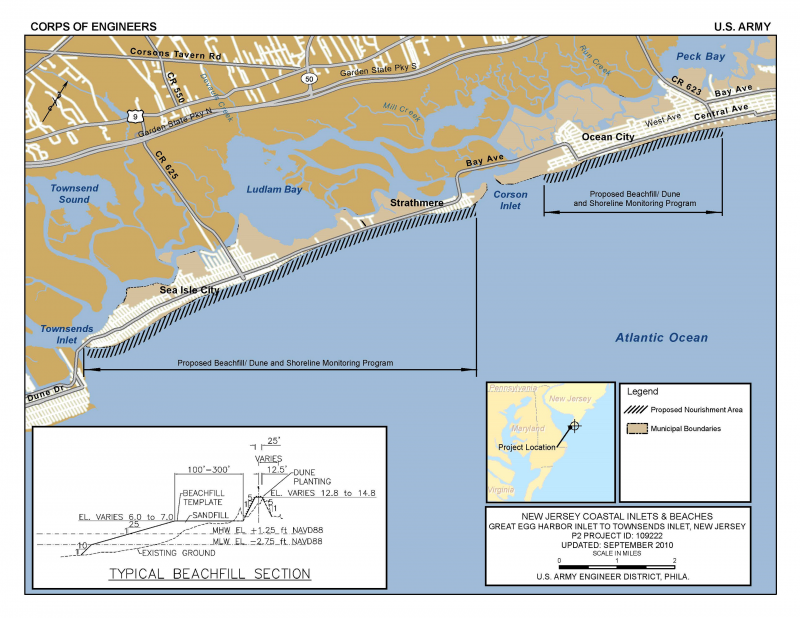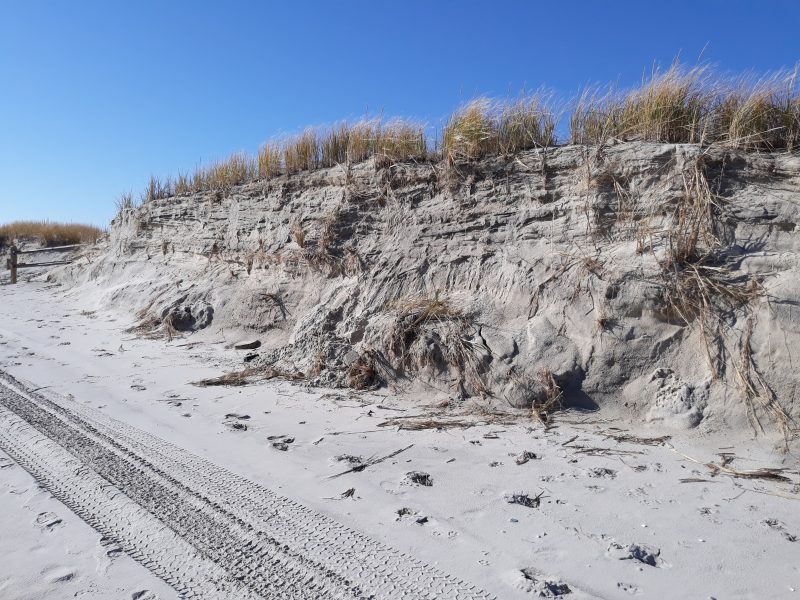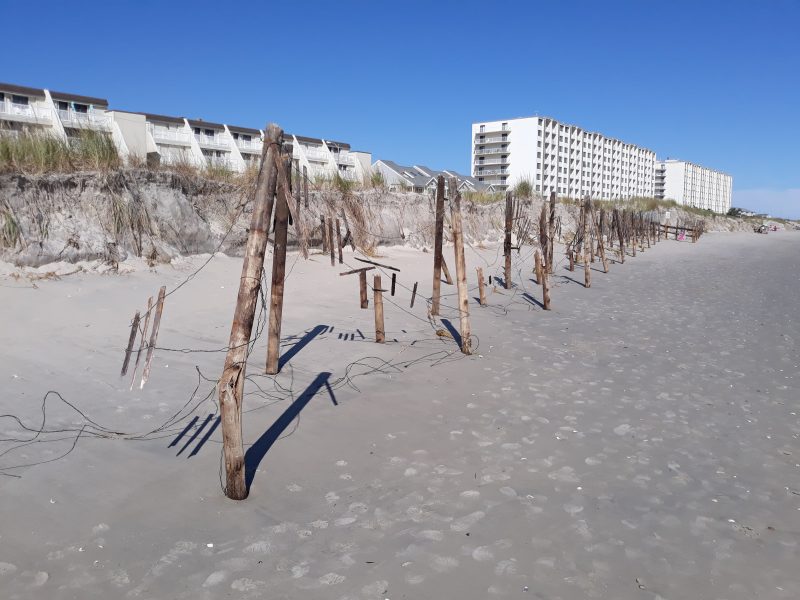A map shows the extent of the beach replenishment project involving the towns of Sea Isle City, Strathmere and Ocean City.
 By DONALD WITTKOWSKI
A beach replenishment project designed to restore Sea Isle City’s storm-eroded shoreline with more than 750,000 cubic yards of new sand will be delayed for about a month, but the cause isn’t the coronavirus outbreak.
The U.S. Army Corps of Engineers, the federal agency overseeing the project, says work is now expected to get underway in mid-June instead of the original start date of May.
What has caused the delay is that Great Lakes Dredge & Dock Co., the contractor hired by the Army Corps of Engineers, must first complete other beach replenishment projects before it starts in Sea Isle.
“Our contractor informed us this has nothing to do with COVID-19. It’s related to Great Lakes Dredge & Dock dredge availability due to commitments to other projects,” Army Corps of Engineers spokesman Steve Rochette said in an email.
Sea Isle’s project will be broken into two parts. Plans call for 510,000 cubic yards of sand to be deposited on the beaches from about 75th Street to 93rd Street in Townsends Inlet. Another 250,000 cubic yards of sand will freshen up the beaches from around 28th Street to 53rd Street in the center of town.
The stretch of beach from 28th to 53rd streets will be done first. Work will start in mid-June and take about 15 days to complete. The work between 75th and 93rd streets will start right after that and take about 30 days, Rochette said.
By DONALD WITTKOWSKI
A beach replenishment project designed to restore Sea Isle City’s storm-eroded shoreline with more than 750,000 cubic yards of new sand will be delayed for about a month, but the cause isn’t the coronavirus outbreak.
The U.S. Army Corps of Engineers, the federal agency overseeing the project, says work is now expected to get underway in mid-June instead of the original start date of May.
What has caused the delay is that Great Lakes Dredge & Dock Co., the contractor hired by the Army Corps of Engineers, must first complete other beach replenishment projects before it starts in Sea Isle.
“Our contractor informed us this has nothing to do with COVID-19. It’s related to Great Lakes Dredge & Dock dredge availability due to commitments to other projects,” Army Corps of Engineers spokesman Steve Rochette said in an email.
Sea Isle’s project will be broken into two parts. Plans call for 510,000 cubic yards of sand to be deposited on the beaches from about 75th Street to 93rd Street in Townsends Inlet. Another 250,000 cubic yards of sand will freshen up the beaches from around 28th Street to 53rd Street in the center of town.
The stretch of beach from 28th to 53rd streets will be done first. Work will start in mid-June and take about 15 days to complete. The work between 75th and 93rd streets will start right after that and take about 30 days, Rochette said.
 A map shows the extent of the beach replenishment project involving the towns of Sea Isle City, Strathmere and Ocean City. (Image courtesy of U.S. Army Corps of Engineers)
Even more sand may be coming for Sea Isle, depending on the results of pre-beach replenishment surveys to determine just how seriously the shoreline has been eroded by storms dating back to last fall, he noted.
“The pre-condition surveys can’t be completed earlier than 21 days before sand placement. We are also still attempting to obtain supplemental funding for additional sand quantity due to the impacts of storms last fall,” Rochette said.
Beach restoration work would take even longer to complete if the surveys recommend more sand than the original estimate of 760,000 total cubic yards for the two areas in Sea Isle.
The delay in getting the project started means that the contractor will be out on Sea Isle’s beaches well into the summer tourism season. However, restrictions will be in place to minimize any conflicts between the beachgoers and the massive network of pipes and heavy equipment used by the contractor to pump new sand onto the shoreline.
A map shows the extent of the beach replenishment project involving the towns of Sea Isle City, Strathmere and Ocean City. (Image courtesy of U.S. Army Corps of Engineers)
Even more sand may be coming for Sea Isle, depending on the results of pre-beach replenishment surveys to determine just how seriously the shoreline has been eroded by storms dating back to last fall, he noted.
“The pre-condition surveys can’t be completed earlier than 21 days before sand placement. We are also still attempting to obtain supplemental funding for additional sand quantity due to the impacts of storms last fall,” Rochette said.
Beach restoration work would take even longer to complete if the surveys recommend more sand than the original estimate of 760,000 total cubic yards for the two areas in Sea Isle.
The delay in getting the project started means that the contractor will be out on Sea Isle’s beaches well into the summer tourism season. However, restrictions will be in place to minimize any conflicts between the beachgoers and the massive network of pipes and heavy equipment used by the contractor to pump new sand onto the shoreline.
 Huge amounts of sand have been washed away from some of the dunes, leaving them with steep, cliff-like walls.
Sea Isle suffered significant beach erosion in some spots during a lingering coastal storm that unleashed a series of unusually high tides over a four-day period in early October.
During the storm, huge chunks of sand were sliced away from the dunes, leaving cliff-like walls in some areas. Some beaches appeared bare – stripped of their powdery top layer of sand. Wooden dune fencing was torn to shreds.
Even before the October storm, beaches and dunes in Townsends Inlet between 88th and 93nd streets had suffered significant erosion. The sand dunes, in particular, were sheared away by the churning surf, creating jagged cliffs more than 10 feet high.
Most of the replenishment contract involves widening the beaches. However, in some areas the dunes, beach access points and sand fencing will be repaired, Rochette explained.
“We are also modifying the contract to relocate the dune landward from 88th to 93rd streets,” he said. “It is hoped this will help prevent or reduce future dune erosion in this area that sustained the most damage since initial construction.”
Sea Isle is part of a $32.5 million beach replenishment project that also includes Strathmere and Ocean City. There are options in the contract for even more sand if needed, which could increase the cost of the project to $41.3 million.
The project will be funded mostly by the Army Corps of Engineers and the New Jersey Department of Environmental Protection. The three towns will each kick in a smaller share. Sea Isle’s contribution is expected to be less than $2 million, City Business Administrator George Savastano said.
Huge amounts of sand have been washed away from some of the dunes, leaving them with steep, cliff-like walls.
Sea Isle suffered significant beach erosion in some spots during a lingering coastal storm that unleashed a series of unusually high tides over a four-day period in early October.
During the storm, huge chunks of sand were sliced away from the dunes, leaving cliff-like walls in some areas. Some beaches appeared bare – stripped of their powdery top layer of sand. Wooden dune fencing was torn to shreds.
Even before the October storm, beaches and dunes in Townsends Inlet between 88th and 93nd streets had suffered significant erosion. The sand dunes, in particular, were sheared away by the churning surf, creating jagged cliffs more than 10 feet high.
Most of the replenishment contract involves widening the beaches. However, in some areas the dunes, beach access points and sand fencing will be repaired, Rochette explained.
“We are also modifying the contract to relocate the dune landward from 88th to 93rd streets,” he said. “It is hoped this will help prevent or reduce future dune erosion in this area that sustained the most damage since initial construction.”
Sea Isle is part of a $32.5 million beach replenishment project that also includes Strathmere and Ocean City. There are options in the contract for even more sand if needed, which could increase the cost of the project to $41.3 million.
The project will be funded mostly by the Army Corps of Engineers and the New Jersey Department of Environmental Protection. The three towns will each kick in a smaller share. Sea Isle’s contribution is expected to be less than $2 million, City Business Administrator George Savastano said.
 Emblematic of broader damage caused by the storm last October, the wooden dune fencing was ripped to shreds on the beach between 39th and 40th streets.
Emblematic of broader damage caused by the storm last October, the wooden dune fencing was ripped to shreds on the beach between 39th and 40th streets.